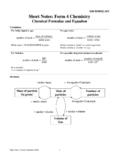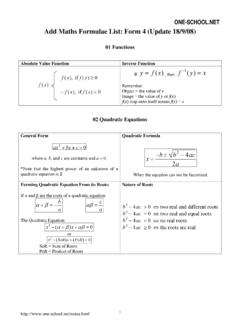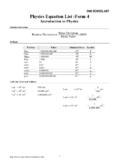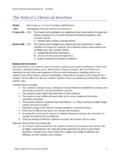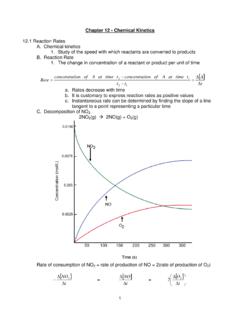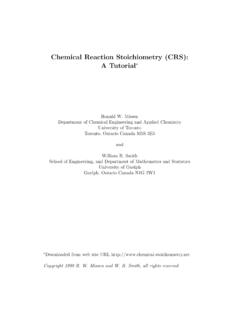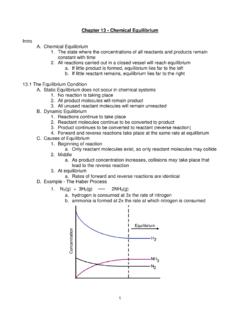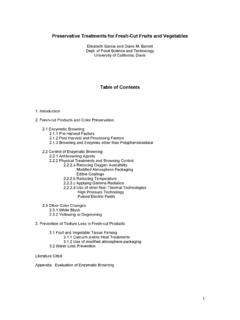Transcription of ONE-SCHOOL.NET Short Notes: Form 5 Chemistry
1 1 Short notes : form 5 Chemistry Rate or Reaction Calculation Rate of Reaction (Average Rate) Quantity change of reactants/productsRates of reaction = Total time for the reaction If the quantity change is immeasurable 1 rates of reaction = Total time for the reaction Find the Rate From a Graph Average Rate rates At an Instant The rate of reaction is equal to the slope of the graph of quantity against time. (Product)Rate of Reaction = (Time) The rate of reaction at an instant, t, is equal to the slope of tangent at that instant. (Product)Rate of Reaction = (Time) 2 Chemical Reaction Precipitation of Sulphur 2 HCl(aq) + Na2S2O3(aq) 2 NaCl(aq) + S(s) + SO2(g) + H2O(l) notes : 1.
2 Yellow precipitate (sulphur) is formed. 2. The reaction is slow. Na2S2O3: Sodium thiosulphate Potassium Dichromate (VI) with Ethanedioic Acid Cr2O72- + 14H+ + 3C2O42- 6CO2 + 7H2O + 2Cr3+ notes : 1. In the reaction, the orange colour of the solution turns into green. Cr2O72-: dichromate(VI) ion (Orange) C2O42-: ethanedioate ion (Colourless) Cr3+ : Chromium(III) ion (green) Potassium Manganate(VII) with Ethanedioic Acid 2 MnO4- + 16H+ + 5C2O42- 10CO2 + 8H2O + 2Mn2+ notes : 1. Mn2+ is colourless 2. In the reaction, the purple colour of the solution turns into colourless. MnO4-: Manganate(VII) ion (Purple) Mn2+: Manganese(II) ion colourless Decomposition of Hydrogen Peroxide 2H2O2 - 2H2O + O2 Catalyst: manganese(IV) oxide(MnO2), Iron(III) oxide (Fe2O3), silver (Ag) Haber Process (Manufacture Ammonia) N2 + 3H2 2NH3 (More detail in form 4 Chapter 9) Contact Process(Manufacture Sulphuric Acid) 2SO2 + O2 2SO3 (More detail in form 4 Chapter 9) 3 Ostwald Process (Manufacture Nitric Acid) Stage 1 4NH3(g) + 5O2(g) 4NO(g) + 6H2O(g) notes : 1.
3 Temperature = 900oC 2. Pressure = 4-10 atm 3. Catalyse = Platinum (Pt) Stage 2 2NO(g) + O2(g) 2NO2(g) Dissolve in water 3NO2(g) + H2O(l) 2 HNO3(aq) + NO(g) Carbon Compound Alkane AlkaneCombustionComplete CombustionIncomplete CombustionSubstitution Reaction(Halogenation) Combustion Complete combustion C2H6 + 72O2 2CO2 + 3H2O Incomplete combustion C2H6 + 52O2 2CO + 3H2O C2H6 + 32O2 2C + 3H2O 4 Substitution Reaction Alkene AlkeneCombustionComplete CombustionIncomplete CombustionAddition Reaction+ Bromine/Chlorine+ Potassium Manganate(VII)+ Hydrogen+ Hydrogen Halide+ SteamPolymerizationAlkaneAlcoholCrakingD ehydration Preparation of Alkene Cracking of Alkane 2C4H10 CH4 + C2H4 + C2H6 + C3H6 Dehydration of Alchohol C2H5OH + C2H4 + H2O 5 Combustion: Complete combustion: C2H4 + 3O2 2CO2 + 2H2O Incomplete combustion C2H4 + 2O2 2CO + 2H2O C2H4 + O2 2C + 2H2O Addition Reaction: + Bromine: + Potassium Manganate(VII): + Hydrohen: (Catalyst: platinum/nickel) + Hydrogen Halide: + Steam (H2O): (Catalyst: phosphoric acid; Temperature: 300oC; Pressure: 60atm) Polymerization (Catalyst: oxygen; Temperature: 200oC.)
4 Pressure: 1200atm) 6 Alcohol AlkeneCarbohydrateAlcoholfermentationAdd ition+ SodiumdehydrationCombustionOxidation(+K2 CrO7/KMnO4) Preparation of alchohol Fermentation of Carbohydrate (Glucose) C6H12O6 2C2H5OH + 2CO2 Addition of Alkene C2H4 + H2O C2H5OH [Catalyst:Phosphoric acid; Temperature:300oC; Pressure: 60atm ] or C2H4 + H2SO4 CH3CH2 OSO3H CH3CH2 OSO3H + H2O CH3CH2OH + H2SO4 Combustion of Alcohol C2H5OH + 3O2 2CO2 + 3H2O Dehydration of Alcohol C2H5OH + C2H4 + H2O Alcohol + Sodium 2C2H5OH + 2Na 2C2H5 ONa + H2 Oxidation of Alcohol C2H5OH + 2[O] CH3 COOH + H2O 7 Carboxylic Acid AldehydesAlchoholCarboxylic acidOxidationOxidation+ Metal+ oxide base+ alkali+ Metal carbonate+ AlchoholSalt + H2 OSalt + H2 OSalt + H2 Salt + CO2 + H2 OEsther Preparation of Carboxylic acid Oxidation of Alcohol C2H5OH + 2[O] CH3 COOH + H2O Oxidation of Aldehyde C2H6O + [O]
5 CH3 COOH Reaction Carboxylic Acid + Alkali CH3 COOH + NaOH CH3 COONa + H2O Carboxylic Acid + Metal Oxide 2CH3 COOH + MgO Mg(CH3 COO)2 + H2O Carboxylic Acid + Metal 2CH3 COOH + Mg Mg(CH3 COO)2 + H2 Carboxylic Acid + Metal Carbonate 2CH3 COOH + CaCO3 Ca(CH3 COO)2 + CO2 +H2O Carboxylic Acid + Alchohol CH3 COOH + C2H5OH CH3 COOC2H5 + H2O 8 Summary of The Reaction 9 Oxidation and Reduction Iron(II) to Iron(III) Oxidising agent: Chlorine or Bromine + Fe2+ Fe3+ + e Cl2 + 2e 2Cl 2Fe2+ + Cl2 2Fe3+ + 2Cl + Fe2+ Fe3+ + e Br2 + 2e 2Br 2Fe2+ + Br2 2Fe3+ + 2Cl Observation: 1. The green colour of Fe2+solution turns brown Observation: 1.
6 The green colour of Fe2+ solution turn brown 2. The brown colour of bromine water turns into colourless. Oxidising agent: Potassium Permanganate(VII) + Fe2+ Fe3+ + e MnO4 + 8H+ + 5e Mn2+ + 4H2O 5Fe2+ + MnO4 + 8H+ 5Fe3+ + Mn2+ + 4H2O Observation: 1. The green colour of solution Fe2+ turns brown 2. The purple colour of the MnO4 solution turns into colourless Oxidising agent: Potassium Dichromate(VI) + Fe2+ Fe3+ + e Cr2O72- + 14 H+ + 6e 2Cr3+ + 7H2O 6Fe2+ + MnO4 + 8H+ 6Fe3+ + Mn2+ + 4H2O Observation: 1. The green colour of solution Fe2+ turns brown. 2. The orange colour of the Cr2O72- solution turns green. Oxidising agent: Hidrogen Peroxide + Fe2+ Fe3+ + e H2O2 + 2H+ + 2e 2H2O 2Fe2+ + H2O2 + 2H+ 2Fe3+ + 2H2O Observation: 1.
7 The green colour of solution Fe2+ turns brown Oxidising agent: Concentrated Nitric Acid + Fe2+ Fe3+ + e NO3- + 4H+ + 3e NO + 2H2O 3Fe2+ + NO3- + 4H+ 3Fe3+ + NO + 2H2O Observation: 1. The green colour of solution Fe2+ turns brown 10 Iron(III) to Iron(II) Reducing Agent: More reactive Metal + Fe3+ + e Fe2+ Zn Zn2+ + 2e 2Fe3+ + Zn 2Fe2+ + Zn2+ Observation: 1. The brown colour of the iron(III) solution turn green. 2. Zinc powder dissolve in the solution. Reducing Agent: Sulphur Dioxide + Fe3+ + e Fe2+ SO2 + 2H2O SO42- + 4H+ + 2e 2Fe3+ + SO2 + 2H2O 2Fe2+ + SO42- + 4H+ Observation: 1. The brown colour of the iron(III) solution turn green. Reducing Agent: Hydrogen Sulphide + Fe3+ + e Fe2+ H2S 2H+ + S + 2e 2Fe3+ + H2S 2Fe2+ + 2H+ + S Observation: 1.
8 The brown colour of the iron(III) solution turn green. 2. Yellow precipitate forms in the solution. Reducing Agent: Sodium Sulphite + Fe3+ + e Fe2+ SO32- + H2O SO42- + 2H+ + 2e 2Fe3+ + SO32- + H2O 2Fe2+ + SO42- + 2H+ Observation: 1. The brown colour of the iron(III) solution turn green. Reducing Agent: Tin(II) Chloride + Fe3+ + e Fe2+ Sn2+ Sn4+ + 2e 2Fe3+ + Sn2+ 2Fe2+ + Sn4+ Observation: 1. The brown colour of the iron(III) solution turn green. 11 Displacement of Metal [A more reactive metal can displace a less reactive ion of metal from its compound.] Example: Mg + PbCl2 MgCl2 + Pb 3Zn + Fe2O3 3 ZnO + 2Fe Al + CuSO4 Al2(SO4)3 + Cu Electrochemical Series Reactivity Series Displacement of Halogen [A more reactive halogen can displace a less reactive halide from its compound.]
9 ] Example: Cl2 + KBr KCl + Br2 Br2 + NaI NaBr + I2 F2 + KI KF + I2 Reactivity of Halogen Colour of Halogen and Halide Halogen Colour in water Colour in CCl4 Chlorine (Cl2) Pale Yellow Pale Yellow Bromine (Br2) Brown/Orange/ Yellow Brown/Orange/Yellow Iodine (I2) Brown/Orange/ Yellow Purple Halogen Colour in water Colour in CCl4 Chloride (Cl-) Colourless Colourless Bromide (Br-) Colourless Colourless Iodide (I-) Colourless Colourless More reactive F2 > Cl2 > Br2 > I2 > At2 More reactive K, Na, Ca, Mg, Al, C, Zn, H, Fe, Sn, Pb, Cu, Ag More electropositive K, Na, Ca, Mg, Al, Zn, Fe, Sn, Pb, H, Cu, Ag Kalau Nak Cari Makanan Ada Zat Ferum Seperti Papaya Harus Cari di Argentina 12 The Oxidising Agent and Reducing Agent Oxidising Agent (Reduction) Redusing Agent (Oxidation)
10 Halogen Cl2 + 2e 2Cl Br2 + 2e 2Br I2 + 2e 2I Metal Mg Mg2+ + 2e Zn Zn2+ + 2e Al Al3+ + 2e Metal Ion Mg2+ + 2e Mg Pb2+ + 2e Pb Sn2+ + 2e Sn Halide Ion 2Cl Cl2 + 2e 2Br Br2 + 2e 2I I2 + 2e Fe3+ Fe3+ + e Fe2+ Fe2+ Fe2+ Fe3+ + e Potassium Manganate(VII) MnO4 + 8H+ + 5e Mn2+ + 4H2O Sulphur Dioxide SO2 + 2H2O SO42- + 4H+ + 2e Potassium Dicromate(VI) Cr2O72- + 14 H+ + 6e 2Cr3+ + 7H2O Hydrogen Sulphide H2S 2H+ + S + 2e Hydrogen Peroxide H2O2 + 2H+ + 2e 2H2O Sodium Sulphite Aqueous SO32- + H2O SO42- + 2H+ + 2e Concentrated Nitric Acid NO3- + 4H+ + 3e NO + 2H2O Tin(II) Chloride Aqueous Sn2+ Sn4+ + 2e Rusting Step 1: Formation pf Ion Anode: Fe Fe2+ + 2e Cathode: O2 + H2O 4OH- + 4e Step 2: Corrosion of Iron Fe2+ + 2OH- Fe(OH)2 Step 3: Formation of iron(III) hydroxide 4Fe(OH)2 + H2O + O2 4Fe(OH)3 Step 4.
